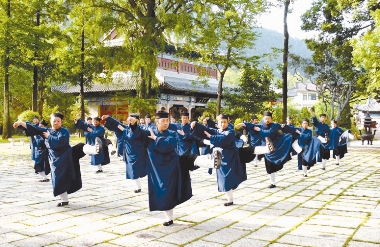
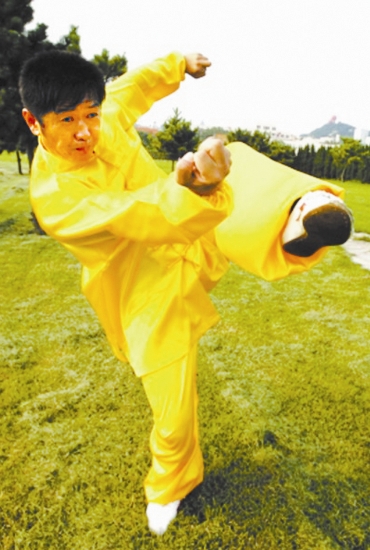
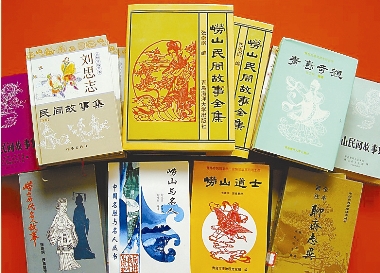
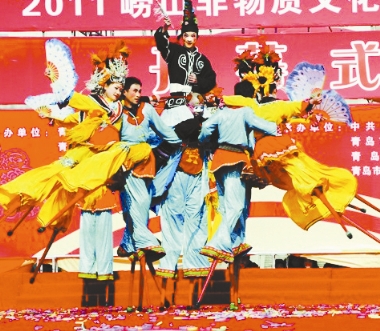
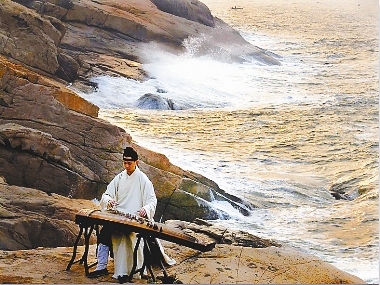 A LAOSHAN intangible cultural heritage festival was held in Qingdao from Feb. 15 to 19, featuring more than 100 State and city-level intangible heritage items. Laoshan has always prided itself on its intangible cultural heritage, including Taoist music, folk tales and Shazikou temple fairs. Taoist music LAOSHAN is home to a number of Taoist temples, palaces and caves. In 2006, Taoist music was listed on the country’s second list of intangible heritage items. Laoshan Mountain is one of the places where Taoism originated and one of Taoism’s most important destinations for pilgrims. The Taoist music follows the Quanzhen School, commonly called Complete Reality in English, which is a major Taoist sect that originated in Northern China. The Quanzhen Taoists were among those who exerted great efforts in keeping the peace, thus saving thousands of lives. The Quanzhen School of Taoist music has also combined local dialects and the folk music of Shandong Province. Shanshan Taoist music is known for its simple, elegant and natural style. To pass the music onto their descendents, ancient Taoist music masters used oral instruction and, more importantly, developed a unique way to record sounds written in books. Ancient scholars also contributed to the production, improvement and promotion of Laoshan Taoist music. It is said that Li Bai, one of the most renowned poets in Chinese history, produced a piece of music while enjoying wine on Laoshan Mountain and the music has been played in several large temples on the mountain until now. (Jane Lai) Laoshan folk tales ALTHOUGH many people know the long list of scenic spots in Qingdao, few can relate the stories behind the attractions. Zhang Chonggang, who was called on to carry on the State-level intangible heritage of “Laoshan Folk Tales,” has compiled a number of folk tales in a book. Laoshan folk tales were spread by word-of-mouth over generations and are considered an important part of Laoshan intangible cultural heritage. Most are about heroes, religious people, immortals, animals and ancient wisdom. (Jane Lai) Praying Mantis DURING the Laoshan intangible cultural heritage festival, a master of Praying Mantis Boxing, a style of Chinese martial arts, Chen Leping, showed Praying Mantis skills with his followers. Praying Mantis is sometimes called Shandong Praying Mantis after its province of origin. It is one of the 10 Chinese martial arts schools. Shandong was once called “Praying Mantis’ Nest” because there was a large number of people studying Praying Mantis in the 1960s and 1970s. Praying Mantis is especially known for its speed and continuous attacks. Wrist and arm techniques in particular are emphasized, as well as knee and elbow strikes. Another prominent feature of the style is its complex footwork. Legend has it that in the late Ming Dynasty (1368-1644), Wang Lang, a monk at Huayan Temple on Laoshan Mountain, was once defeated by another martial arts exponent at the Shaolin Monastery in Henan Province. He then saw a praying mantis hunting cicada and, inspired by its hunting skills, he developed a form of martial arts called Praying Mantis. Soon he defeated his competitors. Praying Mantis was then popularized in Shandong Province and later developed into four families, Taiji, Seven Star, Plum Blossom and Liuhe. (Jane Lai) Xuanzhen martial arts ALSO demonstrating martial arts skills during the Laoshan festival was Kuang Ruhu, a master of Xuanzhen Neijia martial arts. The 600-year-old Xuanzhen Neijia martial arts play an important role in Laoshan Taoist culture. It is said that Xuanzhen Neijia was developed by Zhang Sanfeng, a legendary Chinese Taoist priest during the late Yuan Dynasty (1279-1368) and early Ming Dynasty (1368-1644). He was believed by some to have achieved immortality. Some people believe Zhang passed Xuanzhen Neijia to Taoists on Laoshan Mountain, who then developed the martial arts into their own style. In 2008, Taiqing Palace on Laoshan Mountain established the first Taoism martial arts troupe in Shandong. (Jane Lai) Other festival highlights DURING the Laoshan intangible cultural heritage festival, there were also performances of Digong Boxing, 150-year-old Sunjia Xiazhuang Dragon Dance, paper-cutting, the Donghan Lion Dance, Gouya Stilts and temple fairs. (Jane Lai) | 
